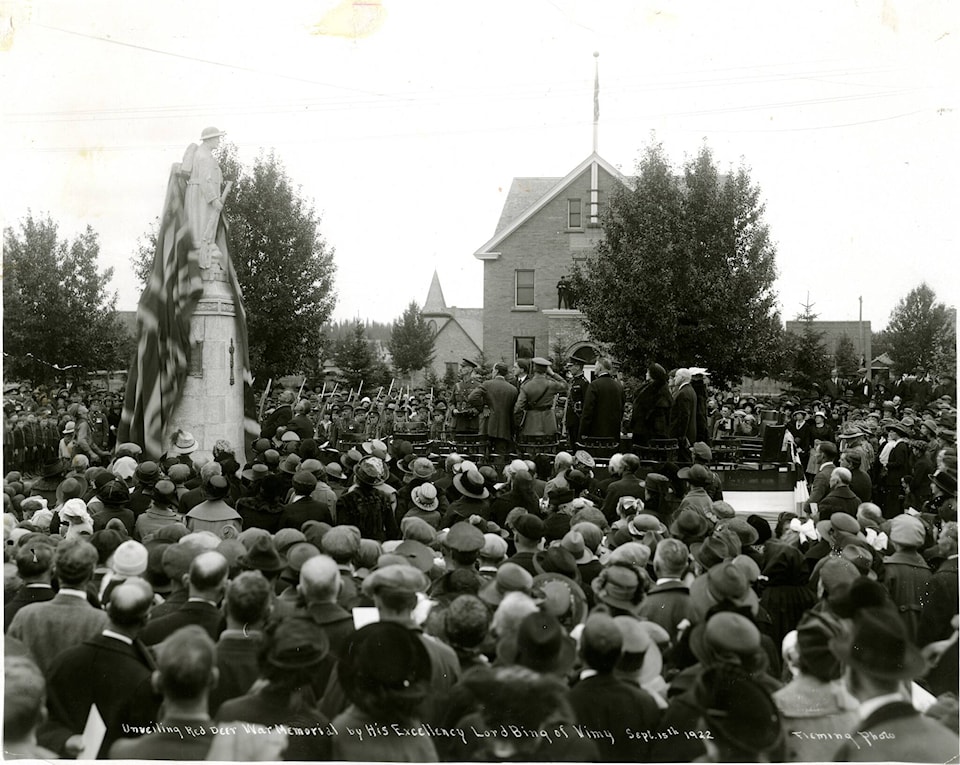One hundred years ago, on September 15, 1922, Lord Byng of Vimy, the Governor General of Canada, officially unveiled the Red Deer Cenotaph, the community memorial to those who had served and those who had lost their lives in the First World War. The Cenotaph has since become one of Red Deer’s most important landmarks in the Downtown area as well as one of Red Deer’s finest pieces of public art.
The origins of the Cenotaph go back to the end of the First World War. That conflict had been a searing experience for Red Deer. 850 from the City and surrounding districts had enlisted. Of these, 118 lost their lives. Of those who returned, many had suffered terrible wounds and faced a lifetime of ill health and suffering.
On December 18, 1918, five weeks after the end of the War, the Central Alberta local of the Great War Veterans Association organized a large public meeting to discuss an appropriate memorial to those who had served and those “who will never return”.
Three proposals were made. The first was to construct a pyramidal monument of river cobblestones in the centre of the City. The second was to construct a community hall and recreation facility next to City Hall. The third was to purchase the old Alexandra (Park) Hotel and turn it into a community centre.
Fundraising began immediately, but proved quite a challenge. Post-war Red Deer faced one of the worst economic depressions in its history. However, despite the general shortage of money, by the following summer more than half of the $6200 needed had been raised.
As the project proceeded, a decision was made to build a monument rather than a community centre. At the suggestion of Lochlan MacLean, it was also decided that the monument be in the form of a statue of a soldier rather than a cobblestone pyramid or obelisk.
Major Frank Norbury, an architectural sculptor from the University of Alberta and a veteran of the War, was commissioned to carve the statue. He carved it out of a 7000 lb. (3175 kg.) block of Tyndall limestone. It was decided to use this material rather than marble because the limestone was native to Western Canada and thought to be longer lasting in the harsh prairie climate.
The statue represented the Unknown Soldier as he was coming off active duty on the front line. He was to face west, toward home and peace. He was also to be positioned towards the C.P.R. station from which most of the soldiers had left Red Deer for the War.
This latter point was part of one of the longest controversies about the Cenotaph. Some had wanted it in the centre of the City Square (now City Hall Park). However, the majority wanted it facing directly towards the station and in the middle of Red Deer’s busiest street so that it would be a constant reminder of the sacrifices of the War.
There was another debate regarding the proper means of recording the names of those killed in the War. Some wanted tablets placed on the pedestal. However, the Memorial Committee was worried about having a complete and accurate list. Finally, it was agreed to have two scrolls prepared, one with the names of those who had served and one with the names of those who had lost their lives. Both scrolls were put into a copper tube and placed in a cavity in the pedestal.
On September 15, 1922, the Cenotaph was officially unveiled. To the delight of the community, Lord Byng of Vimy, agreed to do the honours. He had been the commander in the Battle of Vimy Ridge, which many considered to be one of the most important victories of Canadians in any war. An enormous crowd gathered for the ceremony.
The Cenotaph was rededicated in 1949 to include remembrance of those who served and lost their lives in the Second World War. Another plaque was added in 1988 in memory of those who served and died in the Korean Conflict.
In more recent years, Veterans’ Park has been created around the base of the Cenotaph. Interpretive signage has been added to tell the stories of Red Deer in times of war and also the community’s involvements in peace-keeping operations.
Michael Dawe is a Red Deer historian and his column appears on Wednesdays.
